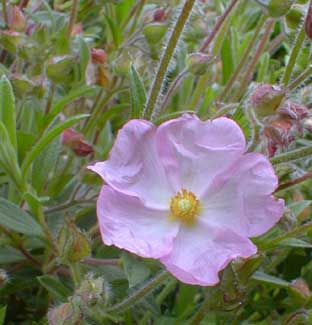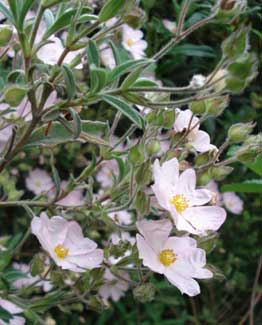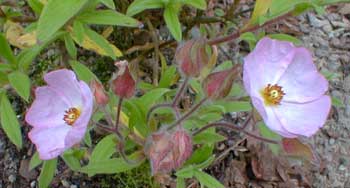
Skanberg's
Rockrose
"How sweet the breath
beneath the hill
Of Sharon's dewy rose!"
-Reginald Heber
1783-1826
1783-1826
 Cistus x skanbergii is a naturally occuring hybrid of C. parviflorus x C. monspeliensis, & is native to Greece & Sicily.
Cistus x skanbergii is a naturally occuring hybrid of C. parviflorus x C. monspeliensis, & is native to Greece & Sicily.I've seen it in nurseries tagged as if with a cultivar name, 'Pure Pink' (it's yellow center notwithstanding), purporting to be more compact than the naturally occurring hybrid. But this is not a registered cultivar name & 'Pure Pink' is essentially just a selected clone of the naturally occurring shrub. There is a second variety, however, a pure white form called 'Albiflorus.'
Upright, mounding, & spreading in habit, it is usually about three feet high & four wide. If unrestrained it can reach grow to four feet of height & six feet width, as ours has done. Early spring or post-bloom sheering helps keep it a bit restrained in size, but it grows back rather swiftly.
Skanberg's Rockrose produces huge numbers of one-inch pale pink flowers starting no later than May. Ours is fully aflower mid-April, ahead of most of the rockroses. These last all of June, sometimes until early July. It reblooms in autumn after a summer's end sheering.
 The blooms have a paperiness but also a metalic shininess, unusually pretty even for such a beautifully flowering genus.
The blooms have a paperiness but also a metalic shininess, unusually pretty even for such a beautifully flowering genus.Slender sage-green foliage is evergreen through winter, with a finer softer texture than the majority of rockroses. As a large groundcover it is very densely leafed & easily keeps weeds from establishing.
If temperatures fall below 20 degrees F., it can have considerable winter damage & need to be hard-pruned just before spring. In mild climates it needs sheering only to control its spread & simply looks good year-round, & super impressive when flowering, sometimes so densely that the blooms almost hide the leaves.
It's a good shrub for erosion control in harshly sunned dry locations. Maritime conditions do not harm it, & it bares up to winds & heat very well. It's drought hardiness is extreme.
The only thing it cannot abide are extended freezing or too much water. To do well in the rainy Northwest it needs the absolute best drainage that can be provided. In our climate by Puget Sound, an established Skanberg's rockrose literally never needs to be watered.